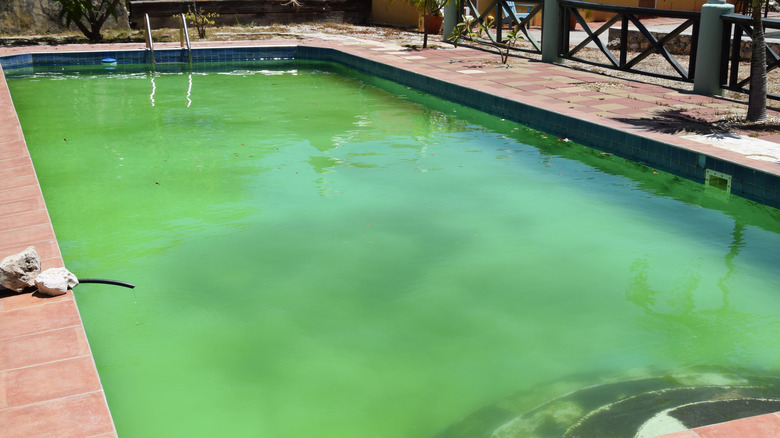Is It Safe To Swim In A Pool With Algae?
Nothing's better than an afternoon dip in the crystal clear waters of your backyard pool. But what if that water isn't so crystal clear? If your pool water has taken on an unusual tint, it's possible you may be experiencing an algae bloom, according to experts at Pool Marvel. While some types of swimming pool algae are not considered a direct danger to human health (via Flawless Image Pool Service), other types of algae can pose some potentially serious health risks, reports Pool Marvel.
When it comes to algae, most of us probably imagine a slimy, green coating on the surface of the water. Yet experts at Pool Marvel explain that the types of algae found lurking in swimming pools can range from green algae to black algae, to mustard algae and red algae. First and foremost, an algae-infested swimming pool can pose some physical health risks (per Flawless Image Pool Service). For instance, algae's slimy coating can make it easy to slip, making one more susceptible to bruises or broken bones. Additionally, algae growth can obscure the color of pool water, making it murkier and less transparent. This can increase drowning risk, as it becomes more difficult to see swimmers in need of help. In swampy areas of the U.S., this can also make it harder to spot unwelcome visitors, such as alligators, that sometimes make their way into swimming pools.
Health risks of swimming in algae-infested pools
As previously mentioned, green algae is not considered harmful to humans in and of itself, but it does serve as a food source to potentially dangerous bacteria, reports Flawless Image Pool Service. This can lead to rashes if bacteria comes in direct contact with the skin, as well as fever, diarrhea, and more if swallowed. Alternatively, mustard algae, which takes on a yellow tint, can carry E.coli (via Pool Marvel). Experts at the Mayo Clinic explain that symptoms of E.coli can include nausea, vomiting, stomach cramping, and bloody diarrhea.
Perhaps posing the most significant risk is red algae, as it is technically bacteria, according to Pool Marvel. The way red algae makes its way into pools is through contamination from weather, pool toys, or most commonly, humans (per Pool Chemical Service). Similar in color to rust, red algae contains toxins that can prompt redness, skin irritation, vomiting, nausea, and respiratory difficulties. Exposure to red algae can be fatal. Therefore, you'll want to refrain from swimming until you've had your pool water professionally treated.
In addition to being unsightly, your health and safety cannot be guaranteed when swimming in a pool with any kind of algae. Therefore, it's best to avoid doing so altogether. In the event that you experience illness after exposure, it's best to speak with a physician.


